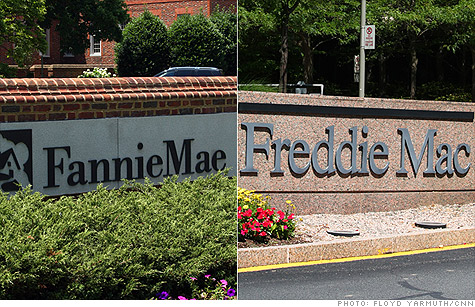Search News

Latest estimate trims cost of mortgage finance giants' bailout to $124 billion, still leaving it as the most expensive bailout of the financial crisis.
NEW YORK (CNNMoney) -- The cost to taxpayers for bailing out mortgage finance giants Fannie Mae and Freddie Mac won't be quite as bad as previous estimates, according to the federal agency overseeing the two companies.
The Federal Housing Finance Agency now estimates that the net cost of the bailouts through 2014 will be about $124 billion, down about 19% from an estimate of $154 billion a year ago.
While the $124 billion cost estimate is the most likely scenario, depending on the housing market, the overall economy and the performance of the loans Fannie and Freddie back, the agency gave a best-case and worst-case estimate range of between $121 billion and $193 billion.
The agency report said the estimate was lowered because Fannie and Freddie needed less bailout funds over the last year because of their better than expected financial results.
The net estimate subtracts the amount being returned to taxpayers through dividends. The total cost of the bailout -- including the 10% dividends Fannie and Freddie owe to the U.S. Treasury -- is now expected to be $226 billion.
The best-case, worst-case range of total costs is between $220 billion and $311 billion.
Even with Thursday's improved loss estimates, the net cost of the bailout of the two firms will still be the most expensive rescue effort by the Federal government during the financial crisis of 2008 and 2009.
Fannie Mae and Freddie Mac declined to comment on the report by their regulator.
The two companies were essentially taken over by the government in September 2008 when they were placed in conservatorship and given large cash infusions to cover mounting losses on the mortgages they owned and guaranteed.
Earlier that summer Congress had given Treasury a virtual blank check to prevent a complete collapse of the nation's housing market due to lack of available credit.
Other bailout efforts, such as the biggest source of the bailouts: the Troubled Assets Relief Program (TARP), had a larger initial price tag but the overwhelming majority of the $474.8 billion it gave out has been returned to Treasury.
In a separate report Thursday, the Special Inspector General for TARP estimated that the fund is still owed $186.8 billion. Much of that money is expected to be recouped. Government estimates from earlier this year put eventual losses from all of TARP programs between $19 billion and $48 billion.
FHFA's report Thursday estimated that future profits by Fannie and Freddie will start to reduce the net costs of the bailouts starting in 2012 or 2013.
Tougher lending standards have allowed the firms to profit from more recent loans it purchased, even if they continue to suffer losses on loans made during the housing bubble. The two firms are now financing about two thirds of the mortgages being written in the United States.
But that doesn't mean that they'll ever be able to repay all of the money they received.
"It ought to be clear to everyone at this point, given the (firms) losses since being placed into conservatorship..(they) will not be able to earn their way back to a condition that allows them to emerge from conservatorship," said Edward DeMarco, the acting director of FHFA, in a speech last month. ![]()